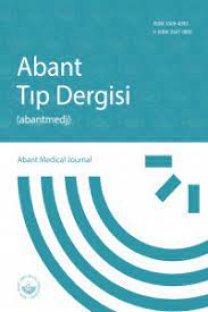Jeneralize liken planusta dar-bant UVB tedavisi
AMAÇ: Liken planus LP sık görülen inflamatuar bir deri hastalığıdır. Son zamanlarda dar-bant ultraviyole B UVB fototerapisinin LP tedavisinde etkili olduğu bildirilmektedir. Bu çalışmada jeneralize LP’li hastalarda dar-bant UVB tedavisinin etkinliği ve güvenilirliğinin değerlendirilmesi amaçlanmıştır.YÖNTEMLER: Çalışmamızda Ocak 2009 ve Aralık 2012 tarihleri arasında kliniğimiz fototerapi ünitesinde LP tanısı ile tedavi gören hastalara ait veriler retrospektif olarak incelendi. Klinik yanıt, sırasıyla lezyonlardaki iyileşme % 90 ve üzerinde, 51-89%, 21-50% ve % 20'nin altında olduğunda, "tam yanıt", "kısmi yanıt", "az yanıt" ya da "yanıt yok" olarak adlandırıldı.BULGULAR: Bulgular: Çalışmaya 9-71 yaş arasında 20 hasta alındı. Hastaların hastalık süreleri 1-84 ay arasında değişmekteydi ve hastaların %30’unun ek bir sistemik hastalığı vardı. On iki hastada %60 tam yanıt, beş hastada %25 kısmi yanıt, bir hastada %5 az yanıt saptandı ancak iki hastada %10 tedaviye yanıt elde edilemedi. Total seans sayısı ortalaması 45,2 ± 16,4 18-80 ve total kümülatif doz ortalaması 54,6 ± 34,2 J/cm2 olarak belirlendi. Klinik tam yanıt ortalama 37,7 24-50 seansta elde edildi. Fototerapiye bağlı akut yan etkiler sadece üç hastada izlendi. SONUÇ: Dar-bant UVB fototerapisi, jeneralize LP tedavisinde etkili ve güvenilir bir tedavi yöntemidir.
Anahtar Kelimeler:
dar-bant UVB, fototerapi, liken planus, ultraviyole
Narrow-band UVB treatment in generalized lichen planus
OBJECTIVE: Lichen planus LP is a common inflammatory skin disease. Recently, narrow-band ultraviolet B UVB phototherapy has been reported to be effective in the treatment of LP. In this study, we aimed to evaluate the efficacy and safety of the narrow-band UVB phototherapy in patients with generalized LP. METHODS: In our study, the data of the patients with LP who were treated in our clinic’s phototherapy unit from between January 2009 and December 2012 were analyzed retrospectively. Clinical response was named as "complete response”, "partial response”, "poor response” or “no response” when the improvement of the lesions is 90% and higher, 51-89%, 21-50% and below 20%, respectively. RESULTS: The study included 20 patients between the ages of 9-71. Duration of disease of the patients ranged from 1-84 months and 30% of the patients had an additional systemic disease. Twelve patients had complete response 60% , five patients 25% had partial response, and one patient had little response 10% but the response to treatment could not be obtained in two patients 5% . The mean total number of sessions was 45.2 ± 16.4 18-80 and the mean total cumulative dose was 54.6 ± 34.2 J/cm2. Clinical complete response was obtained at average 37.7 24-50 sessions. Acute side effects of phototherapy were observed only in three patients.CONCLUSION: Narrow-band UVB phototherapy is an effective and safe treatment modality in the treatment of generalized LP.
Keywords:
narrow-band UVB, phototherapy, lichen planus, ultraviolet,
___
- 1. Pittelkow MR, Daoud MS: Lichen Planus. Fitzpatricks’s Dermatology in General Medicine. Ed. Wolff K, Goldsmith LA, Katz SI, Gilchrest BA, Paller AS, Leffell DJ. 7th eds. New York, McGraw-Hill, 2008;244- 55.
- 2. Taneja A, Taylor C: Narrow-band UVB for lichen planus treatment. Int J Dermatol 2002;41:282-3.
- 3. Sarıcaoglu H, Karadogan SK, Baskan EB, Tunali S: Narrowband UVB therapy in the treatment of lichen planus. Photodermatol Photoimmunol Photomed 2003;19:265-7.
- 4. Habib F, Stoebner PE, Picot E: Narrow band UVB photo therapy in the treatment of widespread lichen planus. Ann Dermatol Venereol 2005;132:17-20.
- 5. Pavlotsky F, Nathansohn N, Kriger G, Shpiro D, Trau H: Ultraviolet- B treatment for cutaneous lichen planus: our experience with 50 patients. Photodermatol Photoimmunol Photomed 2008;24:83-6.
- 6. Gamil H, Nassar A, Saadawi A, El-Qashishi K, Ahmed F: Narrow-band ultraviolet B phototherapy in lichen planus. J Eur Acad Dermatol Venereol 2009;23:589-90.
- 7. Yamamoto T, Osaki T: Characteristic cytokines generated by keratinocytes and mononuclear infiltrates in oral lichen planus. J Invest Dermatol 1995;104:784-8.
- 8. Krutmann J, Morita A, Elmets A: Mechanisms of photo(chemo)therapy. Dermatological Phototherapy and Photodiagnostic Methods. Ed. Krutmann J, Honigsmann H, Elmets CA, Bergstresser PR. Berlin, Springer, 2001;56-9.
- 9. Sigmundsdottir H, Johnston A, Gudjonsson JE, Valdimarsson H: Narrowband-UVB irradiation decreases the production of pro-inflammatory cytokines by stimulated T cells. Arch Dermatol Res. 2005;297:39-42.
- 10. Voll RE, Herrmann M, Roth EA, Stach C, Kalden JR, Girkontaite I: Immunosuppressive effects of apoptotic cells. Nature 1997;390:350-1.
- Yayın Aralığı: Yılda 6 Sayı
- Başlangıç: 2012
- Yayıncı: Bolu Abant İzzet Baysal Üniversitesi Tıp Fakültesi Dekanlığı
